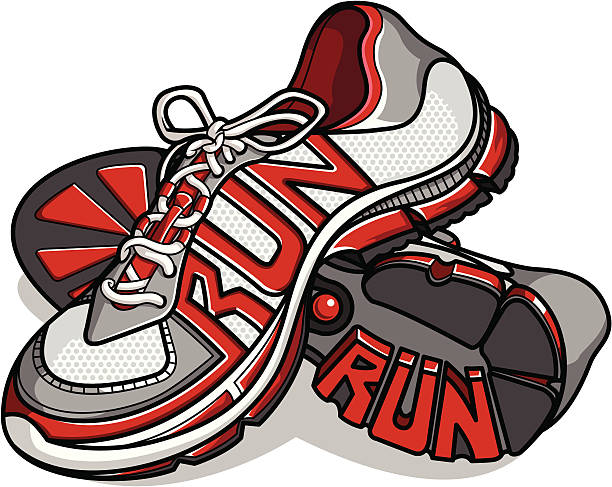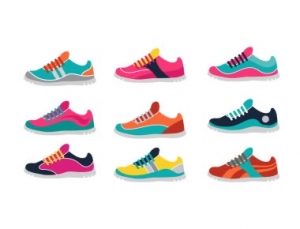- Getting the right fit in the first place also makes a difference. Running shoes should be snug enough through the heel and midfoot so they’re not sliding, but wide enough in the front to allow your toes to spread. If your toes are cramped or your foot’s moving around too much, your shoes (and your feet) may sustain more damage.
- Use your shoes only for running:Wearing running shoes around school, the house, or town might make you feel empowered (and comfortable), but it will also prematurely wear your shoes down. They were born to run—not run errands. If you wear your running shoes casually, those miles also count toward the total. Most performance running shoes typically last about 300 miles, or four months. Those ranges are broad, though, and every shoe and situation is different.
- If possible, rotate two pairs of shoes: The benefit is greater if you use different shoes because your body gains a slight cross-training advantage as it adapts to subtle differences in shoe design. Shoe rotation also gives midsoles time to decompress and the entire shoe time to dry out.
- You should generally replace your running shoes approx. every 300 miles. That’s because it’s around this point that the midsole cushioning on most shoes will lose resiliency and stop absorbing shock as well as when newer, which can cause more impact on your muscles and joints. If you are wearing your running shoes around in normal daytime activities, you are most likely over this threshold and don’t even realize it. Don’t wear running shoes except to run.
- If you notice new discomfort in your feet, legs, knees, hips or back after running, it may be time for a new pair of shoes. The same is true if you’re getting blisters or feeling hot spots where you never used to.
- Research on running in old shoes points to an increased risk of injuries. As the shoe starts to lose its oomph and its ability to hold you up, you’re asking your soft tissues to start working harder.
- This strain can lead to running related overuse injuries in your tendons and ligaments, including Achilles tendinopathy (pain along the tendon that connects your heel to your calf) and plantar fasciitis, an inflammation of the tough band of tissue on the bottom of your foot. And shock traveling up your legs or changes in your gait can even contribute to injuries like stress fractures.
- When the outsoles or treads wear down, your gait may change in a way that increases your risk of injury and also leaves the underlying foam more vulnerable to damage. And holes in the uppers can alter the way the shoe fits your foot, leading to unanticipated problems over time.
How to tell when it’s time to replace your running shoes:
Since shoes don’t wilt, disappear, or come with a sell-by date, how do you know when it’s time to retire them? You can look for clues on your run or on the shoes themselves, and supplement with some tracking over time:
You’re feeling more aches, pains, and other unpleasant occurrences.
- Chances are, you’ll be able to sense that your shoes have broken down before you can see that anything’s amiss.
- If you start to feel as though you’re not getting the performance that you had before, or if you’re starting to get new aches and pains, it might be time for a new pair. Anything from soreness in your heels to knee pain could signal the end of your sneakers; blisters or chafing in new places could also be a sign. Many runners notice they have a type of ache that only appears when their shoes are close to their demise, whether that’s shin splints or hip soreness.
- Finally, you might also just notice that running feels…different. When you get a new shoe, it feels light and lively and bouncy. Older pairs, meanwhile, lack the same spark – the shoe feels dead. And that’s coming from that foam being worn out or compressed to the point that it can’t be rejuvenated. As a result, your pace may slow even if you’re expending the same amount of effort, making running more difficult!
Your shoes literally look a little worse for wear.
- In addition, there are some red flags you can see with the naked eye. Check the hard rubber outsole; if it’s worn through on the sides or bottom, that’s a problem. Every runner has some asymmetries, so you might notice this on one side more than the other.
- The midsole may also appear wrinkled or compressed, a surefire sign it’s not delivering the same amount of cushion or spring. You can also try bending or twisting each shoe. As the foam breaks down, they’ll become more flexible—so if your shoes are a lot bendier than they used to be, they may be past their prime. It can help to repeat this test over time, or compare to a new pair of the same model for a point of reference.
- Finally, inspect the counter. If the heel seems to be leaning one way or the other, appears bent in, or is otherwise misshapen, consider moving on to a new pair. Same if you have holes in the fabric upper. And all these signs are even more significant if they’re combined with aches, pains, or that “dead” sensation from broken-down foam.
Your shoes hit a specific mileage.
- Tracking the mileage isn’t foolproof, but it can help you determine how often to replace running shoes—especially if you combine it with some of the other signals mentioned above. Shoes don’t magically expire at any given number, but you can track trends over time. “At least it gives you an idea—when I wear this shoe, I feel good for 300 miles, whereas when I wear this shoe, they only feel good for 250 miles
















